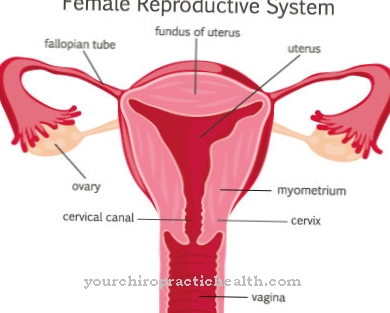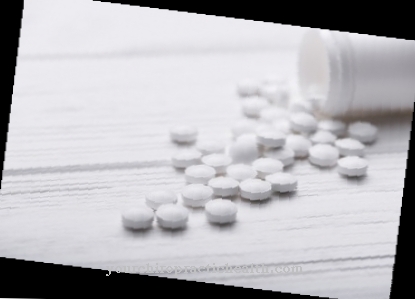Under the nephrotic syndrome one understands in medicine a summary of several symptoms. These occur in various diseases of the kidney corpuscles.
What is Nephrotic Syndrome?

© Prostock-studio - stock.adobe.com
The four key symptoms of the Nephronic Syndrome are edema, proteinuria to a large extent, hyperlipoproteinemia and hypoproteinemia. Proteinuria is the excretion of protein in the urine that exceeds 3.5 grams per day.
Edema causes tissue swelling as water builds up in the body. A reduced concentration of protein is understood as hypoproteinemia. Hyperlipoproteinemia describes an increase in cholesterol and lipoproteins. All of these symptoms arise because the kidneys are no longer properly filtering the blood. The kidney is made up of a million tiny filter units called glomeruli, or kidney corpuscles.
The filter membrane is more permeable as soon as nephrotic syndrome occurs. The organism therefore tries to compensate for the protein deficiency that is caused by a reduced breakdown and increased production of fat.
causes
Among the most common causes of one nephrotic syndrome include chronic kidney disease and minimal change glomerulonephritis, a disease of the kidney corpuscles that occurs mostly in children.
About 15% of the cause of the nephronic syndrome is a chronic disease of the kidney. In this so-called focal segmetal glomerulosclerosis, not all kidney corpuscles are damaged compared to the other two diseases.
Less common causes include progressive kidney disease, kidney involvement in collagenosis and amyloidosis, renal vein congestion, kidney damage from plasmacytoma and complications that can occur in malaria.
Symptoms, ailments & signs
Nephrotic syndrome is associated with some typical symptoms. Initially, the loss of protein is in the foreground. One speaks of proteinuria. The protein is excreted in the urine; clearly recognizable by strong foaming. A deficiency of protein can also be detected in the blood, which is known as hypoproteinemia. In addition, the blood lipid levels rise. This in turn increases the risk of heart attack and coronary artery disease.
In addition, patients often suffer from high blood pressure. Since the organism also loses defenses due to the impaired kidney function, infections are more common. In addition, water collects in the abdomen (ascites) and edema occurs in various places. This leads to weight gain. The accumulation of water can be clearly seen on the face (facial edema), particularly on the eyelids (eyelid edema) or on the lungs.
The pulmonary edema manifests itself with coughing, rattling breathing noises, pale to bluish skin color, racing heart and shortness of breath. As a complication of the disease, the lack of protein can lead to a disorder of blood clotting. This favors the development of thromboses and blood clots, especially in the renal veins.
The severity of the symptoms of nephrotic syndrome varies from person to person. Some patients suffer from severe discomfort, while others hardly feel anything. The disease can lead to chronic kidney weakness and even kidney failure.
Diagnosis & course
The nephrotic syndrome can be primary or secondary. The secondary nephrotic syndrome always occurs in conjunction with diseases such as HIV or cancer. The primary form has no relation to other diseases. If the secondary form is present, the disease can usually be successfully treated with glucocorticoids.
However, relapse often occurs. However, if the nephrotic syndrome is due to focal glomerulosclerosis, treatment is particularly difficult. Then scar tissue is found in the kidney corpuscles so that the kidney filter can no longer perform its function adequately. This can lead to the complete loss of kidney function.
In addition to a conventional urine sample, urine must be collected for 24 hours. A blood test will also provide more information, as it allows the protein level to be checked. But fat metabolism values are also of great importance. Finally, a kidney biopsy is arranged, using a needle to remove an inch or two of kidney tissue.
Complications
In this syndrome, patients suffer from a number of different ailments and symptoms. For this reason, the further course of this disease depends very much on the severity of these symptoms. First and foremost, the patients suffer from a significantly increased susceptibility to infections and a weakened immune system. Inflammations and infections are more common, so that the life expectancy of the patient may also be reduced.
Blood clotting disorders or thrombosis can also occur as a result of this syndrome and further reduce the patient's quality of life. There is also bloody urine and severe pain in the flanks. These can also work out in the back. If this syndrome is not treated, the patient can suffer from complete renal insufficiency and die from it.
This condition is usually treated with the help of medication. As a rule, there are no particular complications. In severe cases, the affected person has to rely on dialysis or a kidney transplant in order to survive.
When should you go to the doctor?
Disorders of the heart rhythm, palpitations or high blood pressure are signs of a health impairment. If the symptoms persist, a doctor should be consulted. Internal heat, easy excitability and a feeling of restlessness are further signs that should be clarified. Those affected need help with sweating, sleep disorders and shortness of breath. If fears, behavior problems and mood swings develop, it is advisable to consult a doctor. Breathing noises, changes in the appearance of the skin and swelling of the body are worrying. If there is water retention, changes in weight or disorders of the musculoskeletal system, research into the cause is indicated.
If the joints can no longer be moved as usual or the general physical resilience decreases, a doctor should be consulted. Discoloration of the skin, internal weakness, and diffuse malaise should be examined and treated. If the person concerned experiences a feeling of illness, he loses the joie de vivre and he can no longer take part in the usual social activities, the observations must be discussed with a doctor. Abnormal urination, pain in the kidney area and changes in body odor are alarm signals of the organism. They must be examined by a medical professional immediately.
Treatment & Therapy
It will be initial nephrotic syndrome treated with glucocorticoids. If relapses occur frequently, this medicine cannot cure it, so other drugs must be used.
These include mycophenolate mofetil, cyclosporine or cyclophosphamide. Combination therapy has a particularly positive effect on some patients. The edema can be brought under control through a low-salt diet, flushing agents, and less drinking. In particularly stubborn cases, albumin infusions are used because the loss of protein can be compensated for in the urine.
ACE inhibitors can be taken to reduce protein excretion. These also lower blood pressure. For some sick people, other antihypertensive drugs must also be used. Nephronic syndrome can cause irreversible damage to the kidneys despite treatment, so a kidney transplant is the last resort. Fortunately, however, this is only the case with a minimal proportion of all sick people.
Outlook & forecast
The prognosis for nephrotic syndrome depends on the type of syndrome, the underlying disease, and the time of diagnosis. The prognosis is particularly good if the syndrome arises from glomerulonephritis. Children can be treated in a targeted manner, whereby the syndrome regresses in many cases.
Other forms of nephrotic syndrome offer a worse prognosis. In most cases, drug treatment using immunosuppressants is necessary, which is associated with serious side effects and interactions. The nephrotic syndrome can also be an expression of severe kidney disease. Diabetics and patients with anti-basement membrane glomerulonephritis have a significantly poorer prognosis, since the causal disease is already well advanced when the nephrotic syndrome occurs.
The prognosis is made by the responsible nephrologist or general practitioner. For this purpose, the previous course of the disease and the stage in which the disease is located are used. A spontaneous improvement in the state of health is possible, but of short duration. Life expectancy in the severe form is severely limited. Many patients die within a few years of being diagnosed. In the milder forms, a full recovery is possible without any long-term consequences.
prevention
Since that nephrotic syndrome is often a consequence of other diseases, one should take care of oneself and one's body through a healthy lifestyle. The kidneys should always be flushed well, which is why the intake of water is particularly important. About two to three liters should be consumed per day.
But unnecessary and excessive use of medication should also be avoided. If there is a slight suspicion of nephrotic syndrome, the doctor should be consulted immediately, as rapid treatment often promises greater success. Furthermore, diseases that could possibly trigger the nephrotic syndrome should be treated early.
Aftercare
In the case of nephrotic syndrome, aftercare consists of continuous treatment of the causes. This includes combating kidney infections as well as optimal control of diabetes and discontinuation of unsuitable medication. If the nephrotic syndrome is based on an autoimmune disease, cortisone is used.
Symptoms that occur when fluid accumulates in the abdomen can be relieved by taking several small meals throughout the day. Diuretics are used for high blood pressure and help reduce tissue swelling caused by fluid retention. These drugs are prescribed by the doctor during regular follow-up examinations and the dose is adjusted to the individual needs of the patient.
Since infections can be life-threatening, they must be treated immediately. Preventive pneumococcal vaccination is recommended to those affected. The prognosis for nephrotic syndrome depends on the cause of the disease. In order to support the healing process, an adequate protein intake should be ensured. If the body receives too little protein, there is a risk that more muscle mass will be lost.
As a rule, 0.8 to 1 gram of protein per day is recommended for every kilogram of body weight. Type 2 diabetics should reduce their salt intake with food and limit it to a maximum of six grams per day. To reduce salt consumption, the intake of processed foods can be reduced, while at the same time the consumption of unprocessed foods such as fruits and vegetables is increased.
You can do that yourself
Nephrotic syndrome is associated with various symptoms. Those affected can alleviate some of the symptoms themselves by making lifestyle changes. Exercise and the avoidance of stress help against high blood pressure. Smokers should give up smoking. The diet should be changed to a Mediterranean diet, which is best composed of raw vegetables, nuts, pasta, eggs and cheese. Salt, caffeine, and alcohol raise blood pressure and should be avoided.
If edema develops, it must be treated according to the doctor's instructions. Affected children and adolescents should use special care products so that the sensitive skin is not further irritated. Since there is an increased risk of blood clots in nephrotic syndrome, parents should watch out for unusual symptoms and, if in doubt, call a doctor. It is also important to wear compression stockings and to take blood-thinning measures. The increased susceptibility to infection can be counteracted by washing clothes and bed linen with hot water several times a week and the patient avoiding dangerous situations in everyday life.
However, if a bacterial infection does occur, a visit to a doctor is recommended. A change in diet and other self-help measures should first be discussed with the responsible doctor in order to avoid complications.





.jpg)







.jpg)

.jpg)
.jpg)











.jpg)